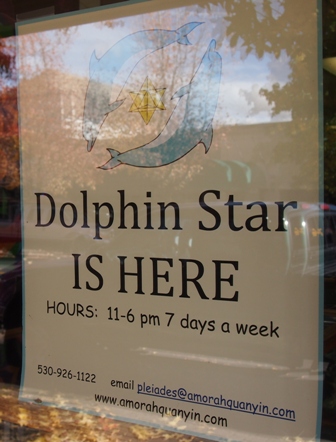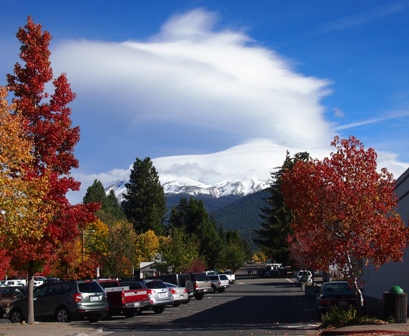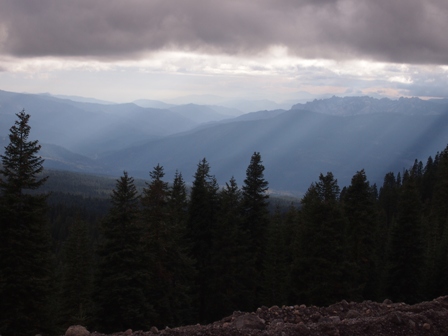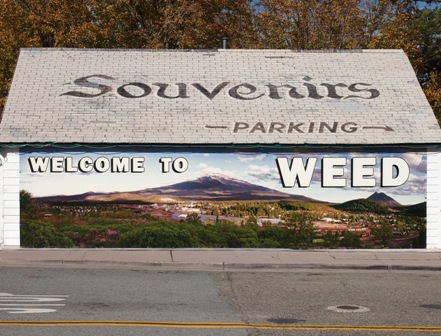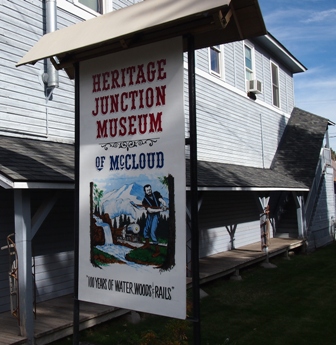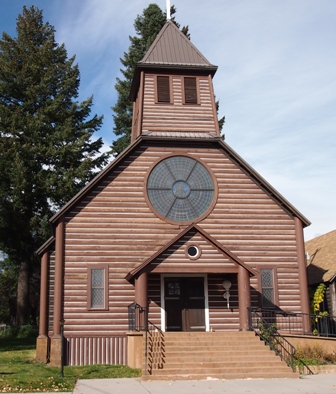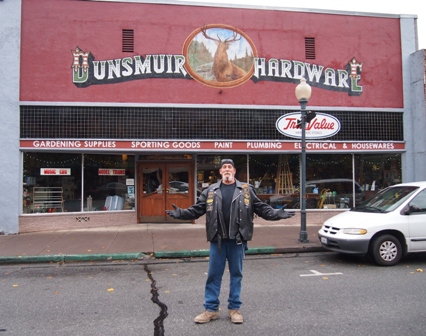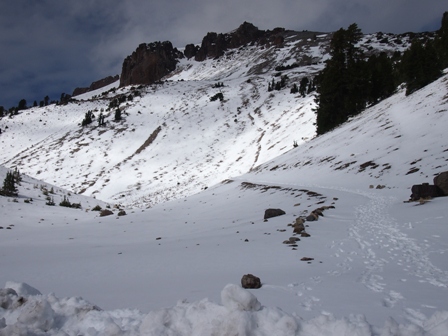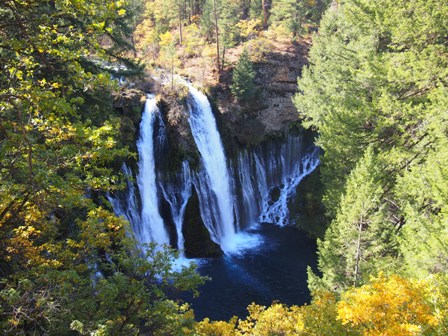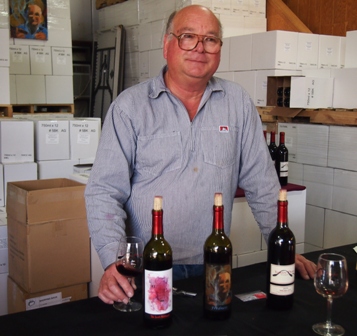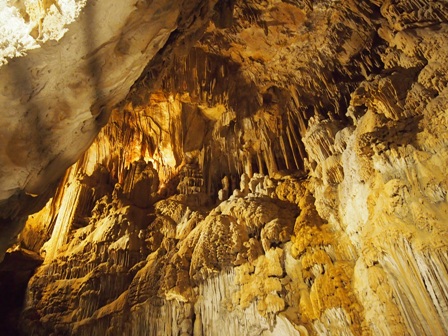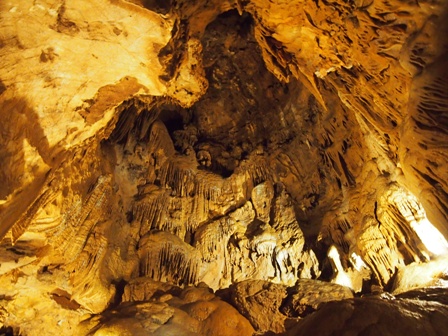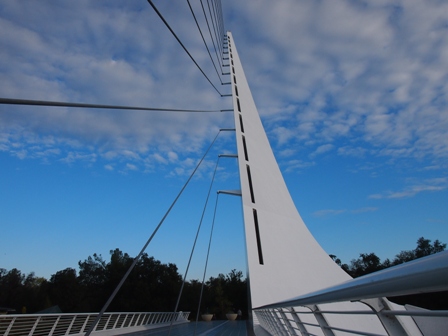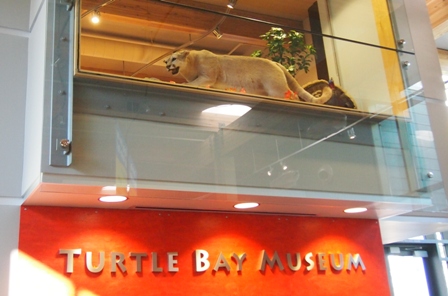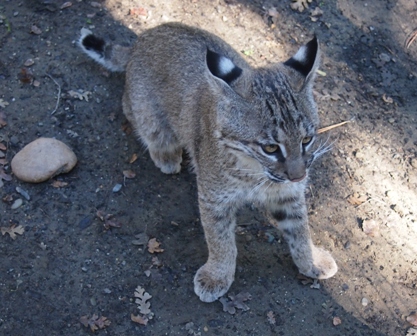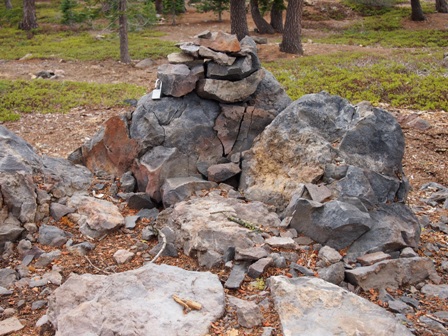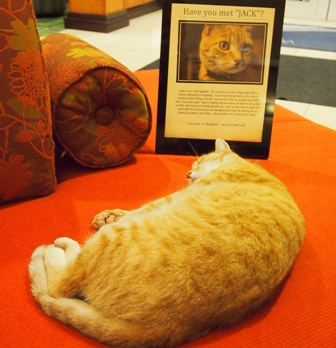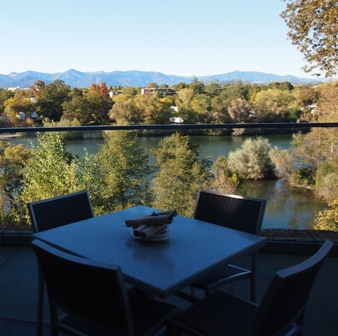Crystals shine along Mount Shasta town’s main street. Clairvoyants, shamans, chakra aligners, yoga teachers, massage therapists, soul diggers; they’re all here because of the mountain.
The new age shops proliferating in Mount Shasta town are drawn by the mountain’s reputation as a direct portal to another dimension. Lemuria, Atlantis, you name it, Shasta is the front door to a mystic house in an alien neighbourhood of alternate reality.
After a brief gold rush in the 1850s, Mount Shasta grew into a small northern California timber town eking a living from tree chopping. Now it’s a small resort town that’s a magnet for big city folk searching for a permanent tree change… or at least a few days escape to the more natural world.
Mount Shasta is the magnet; travellers come here to marvel at its stature, some stay on in thrall to its constant snow capped majesty.
Whatever your inscribed beliefs may be, Mount Shasta is undeniably a stupendous geographical exclamation point. At 4,322 metres, it’s the second highest peak in the Cascade Range (Mount Rainier in Washington at 4,392 metres is the highest). Towering almost 3,000 metres above the surrounding landscape, it stands alone. By volume, it’s the biggest strato-volcano in the whole Cascade Range.
Though it’s officially dormant, the last significant eruption was only about 200 years ago on the massif’s Hotlum Cone. Supposedly the French explorer La Perouse witnessed the explosion while sailing off the California coast in 1786.
Like Mount Rainier, if and/or when Shasta blows again, its impact will be devastating.
But don’t let potential volcanic activity put you off visiting.
This is an environmentally significant wonderland. Endless Conifer forest, beautiful waterfalls, Native American historic sites, numerous national and state parks, excellent trekking and camping and a sophisticated accommodation and dining scene offer ample reasons to linger around the great mountain.
Northern California occupies one third of the state’s area but claims only 3% of its population.
When the crowds down south strain your patience levels, head north for peace and quiet seclusion.
Having visited California many times, I’d never ventured north of San Francisco other than via the Coast Road. While the redwood forests and wild coastline are inspiring, the inland around the Cascades provides an entirely different perspective to what the Golden State is all about.
After a few days ambling round the mountain checking out wineries, national parks and historic towns, I decided it was time to drive up high as I could.
The Mount Shasta summit road ends at a locked gate. Snowdrifts ahead, changing weather, unsafe conditions: explanations listed on an affixed sign said it all. Beyond that point there be dragons.
Alone and curious I walked to the next twist higher up the road. Mount Lassen’s snow covered peak (3,187 metres) shone in momentary bright sunlight from 60 kilometres away.
I’d been there two days before walking amongst steam vents and scalding pools ringed by deep snow, animal tracks crisscrossing open meadows, hoping to see a wolf print, maybe a bear. Rumours of wolves moving south along the Cascade Range from Oregon were all at once real and enticing.
If wolves return to California, the southern Cascades would be their natural home.
Maybe they would mark Mount Shasta as a kind of homing beacon?
Long ago, Native American Indians saw it as a holy place; for most people it still is. Migrating from one food source to another, various Indian tribes used Shasta as a compass point.
Standing alone, sentinel, beacon, point of difference, whatever adjective applied, it’s a helluva’ mountain.
I’d been in its presence, indeed it’s the sort of mountain that demands presence before I decided to drive up the summit road. I’d chosen initially to observe from below, not wanting to disrespect the old spirits said to reside in its secret centre. I wanted to come to a gradual understanding of what Shasta means for all the creatures living around it.
You can’t help but be drawn to it. The mountain creates its own weather, famed for its lenticular cloud formations that hover around the peak like flying saucers.
Nestled into the mountain’s south western flank, Mount Shasta town is where most visitors stay. Here outdoor supply shops selling the newest camping equipment sidle up next to boutiques advertising natural healing or crystal reading and hardware stores offering discounts on pole stumpers and Stetson hats.
The town’s single main street extends for several kilometres curving towards Interstate Highway 5, lined with cafes, organic bakeries, cowboy bars, organic grocery stores, funky restaurants and an interesting collection of curio shops selling scented beeswax candles and books about how Mount Shasta is a portal into an alternate universe.
Strolling Shasta town’s main drag is a walking trip between California’s contemporary counter-culture and its Wild West gold-digging past.
If you spend a few days exploring the region, Mount Shasta town is its centre point; you’ll return to it often.
North of Mount Shasta along Interstate Highway 5 is Weed.
Named for a town founder, Mr Abner Weed, a lumberman who favoured the location because the winds funneling down Mount Shasta’s northern flanks were good for drying timber, Weed town is recognised these days primarily because of its unusual place name.
Fridge magnets and T-shirts with ‘WEED’ in large print and a dope leaf image are popular merchandise. I bought one of each and could have bought a couple freshly rolled joints just as easily but declined getting any higher than I already was at that altitude.
South of Mount Shasta, the towns McCloud and Dunsmuir provide a far more stimulating touristic experience.
McCloud is a former timber town where all inhabitants were company employees. Once a lively community whose heyday was in the 1920s, it dwindled into ghostly obscurity when logging operations were deemed unprofitable in the post war years. Residents were paid in company currency which was accepted only in company stores. Simply put, if you lived in McCloud, you worked in the McCloud sawmill and processing plant or had no other reason to be there. When logging ceased, McCloud emptied.
Now McCloud is a kind of time-warp town as people have returned, renovating lovely wooden houses set in large blocks. Architecturally well-preserved, current residents have taken pride in saving what was once a thriving community. Tourism is the main game, B & B accommodation is popular (particularly with Bay Area folk looking for a mountain escape within a day’s drive) as the region gradually switched its economic focus from logging to eco-tourism.
From McCloud, Mount Shasta’s downhill and alpine ski fields are within easy reach while trekking or rock-climbing in nearby Castle Crags or Trinity Alps state parks is a year-round drawcard.
Not far from McCloud is equally interesting Dunsmuir. Boasting the ‘Cleanest Water in the World’, Dunsmuir was once an important railway town where trains stopped for water and supplies before making the steep ascent to the Mount Shasta foothills and the Cascade Range plateau beyond the great mountain. The forest around Dunsmuir is dense. In fact Dunsmuir is sequestered into a deep valley, a situation immediately apparent when driving into the town centre. Everything is looking up from the main street running along the railway track.
Like Mount Shasta town, Dunsmuir is a thriving municipality. Visitors and residents alike share an obvious fondness for both places. Civic pride is clear as the snow on Mount Shasta’s summit. Nearly everyone I met came here from somewhere else for good reason; escaping big city pressure in pursuit of a relaxed lifestyle was the answer I heard most often. That and living costs were less than in LA or San Francisco.
Wandering around Dunsmuir’s main street, checking out the restored Art Deco cinema, the assortment of cute art galleries and cafes, I ran into a big man in bikie leathers who noticed me taking photos. ‘Where are you from mister?’ he asked me good naturedly. Not accustomed to being greeted in such a friendly manner from an aggressive looking giant in black leather, I responded meekly, ‘Australia’. Cutting a long story short, it happened that the Harley-Davidson loving chap was the town’s mayor. Within a few minutes, he’d invited me into a nearby bar as his guest. Everyone in the bar knew him (how could they not given Dunsmuir’s small size and the mayor’s large presence?). With drink in hand and introductions all round, I suddenly had twenty new best friends.
Like I said, Mount Shasta has gifted its benevolent presence on all who visit it with hearts and minds wide open to new experience. The brief incident in Dunsmuir with the Hells Angels gang leader cum mayor is just one case in point.
Lassen Volcanic National Park was established in 1916 to protect the environment surrounding the world’s largest plug-dome volcano. (See www.basicplanet.com for detailed information about plug-dome volcanoes). The full service visitor centre at the southwest entrance (the easiest access point from Mount Shasta town) is an obligatory stop. USA national parks are among the best in the world. Employees are local experts, uniformly friendly and helpful.
Equally important is the McArthur-Burney Falls Memorial State Park. Saved from development by the McArthur ranching family, this small park (370 ha) is the second oldest in California.
The park’s star attraction is the mesmerising Burney Falls. Even during the worst droughts (such as the one California is suffering now), this waterfall gushes over 200 million litres of spring fed clear water every day. Volcanic fissures stretch deep into the Earth creating a seemingly endless stream that tumbles 39 metres over a basalt cliff into a deep reservoir that mirrors the surrounding forest on a clear day.
Native American Indians came to the falls during summer to cool off and during winter to avoid heavy snow. Game was always plentiful and the waterfall came to be known as a place of peace where the various migrating tribes met in harmony.
Between Mount Shasta and Lassen Volcano is Manton and its high and dry foothill country, good for Vitis Vinifera grapes, reds in particular. Approximately a half dozen vignerons around Manton produce cool climate wines of impressive stature. I checked out Indian Peak Winery outside Manton and am very glad I did. Owned and run by Fred and Donna Boots, it’s a small operation planted to Syrah, Cabernet Sauvignon and Chardonnay. The Reserve Cabernet Sauvignon is particularly good. Red rock volcanic soil and a relatively benign climate (short hot summers and long cool winters) are contributing factors to the high quality of the wines.
I wish I’d had more time to check out other wineries in the district but if time is short Indian Peak is well worth a detour. See www.indianpeakvineyards.net The cellar door is open 7 days a week but ring first to ensure a tasting. Tel: (530) 474 6126 or email ipv@frontier.net
South of Dunsmuir just off the Interstate Highway 5 is the Shasta Caverns. If viewing glistening stalagmites and stalactites while spelunking the Earth’s recesses hold interest, don’t miss this weirdly beautiful limestone cave. Access is from the visitor’s centre across artificial Lake Shasta (created by the Shasta Dam, another site well worth visiting).
Guided tours run several times daily and include a short boat trip across the lake, a steep ride in a bus up a winding road to the hidden cliff side cave and a couple hours exploring this underground marvel that was only discovered by a fisheries employee in 1878.
The cave’s visitor’s entrance is relatively new. Shasta Cavern was virtually hidden from the world by its remote location on the side of a steep cliff overlooking the Sacramento River. Descent was via a small hole in the ceiling until a new entrance was blasted into solid rock in the 1960s.
Most international visitors to Shasta travel by road up from San Francisco or the Central Valley. An airport at Redding allows quicker access though only three flights a day operate between Redding and San Francisco.
Redding is the region’s largest town. If you’re there for an overnight stay be sure to visit the Santiago Calatreva designed Sundial footbridge over the Sacramento River and the adjoining Turtle Bay Exploration Park.
Turtle Bay is more than just a riverside public park. It’s a natural history museum, a wildlife sanctuary and zoo, a Native American Indian museum and an art gallery.
Naked Tip:
If you notice an unusual number of apparently blissed out people wandering the streets of Redding quite likely they’re members of a former Assemblies of God church, now called Bethel Church. Espousing a kind of evangelical Christianity, Bethel Church is rather secretively run by a small hierarchy of church founders. The Bethel School of Supernatural Ministry attracts devotees from around the USA. Approximately 8,000 students attend the school while the church employs hundreds more. See www.bethelredding.com for more information. Many businesses in Redding employ Bethel Church goers. Places where visitors frequent such as motels, restaurants, bars and cafes are staffed by students attending the School of Supernatural Ministry. I inquired often and widely about how the church differentiates itself to other evangelical organisations but was never given a straightforward answer. My initial impression is that it’s a benign organisation that promotes world peace but I am less convinced by the simplistic adherence to doctrine interpreted by a select few church leaders. The church is also overwhelmingly white and middle class. Is it a cult? Of course it is but then I believe all religions are essentially cults run by hierarchies bent on retaining power no matter the spiritual cost incurred. Bethel College’s influence in Redding is overwhelming. Without it, the town’s economy would clearly suffer.
On my last day in Mount Shasta, I drove up to Castle Lake. When I was near Mount Shasta’s summit days before, I happened across a one-man-band beating a wide drum to a tune of his imagination. We were the only two people on the summit road that cold windy day. Sixty something and dressed like he’d spent most of his life reliving San Francisco’s ‘Summer of Love’, his face the colour of a smoked almond and virtually toothless. He reeked of weed was clearly stoned and at times incoherent. In short, he looked like a lot of people I’d noticed around Mount Shasta during previous days. He rambled on about how the mountain could change your life if you let it work its magic on your open mind. His tobacco stained fingers kept up a rhythmic beat on the brightly decorated drum while he strongly advised me to visit Castle Lake where I would see King Arthur’s sword and the Lady of the Lake.
Why should I argue with someone so convinced I would see a legendary English hero in a Californian lake?
Alone at the end of the road again, I parked near Castle Lake’s shore. The water was so clear I could count the dead branches resting in deep water. An eerie wind blew snow flurries around like cold spirits looking for a nice place to get warm. I drew my coat collar closer round my neck asking myself why I had a compulsion to check out local superstition uttered by stoned drummers met on holy mountains.
Irresistible? Did I see Arthur’s sword or hear the Lady of the Lake’s song?
No. But I liked trying.
Mount Shasta is the sort of place where no one would question my motives.
Tom Neal Tacker travelled as a guest of Visit California and the Shasta Cascade Wonderland Association.
Naked Facts:
Naked Routes:
Redding is a four to five hours easy drive north of San Francisco along Interstate Highway 5. Mount Shasta is an hour’s drive north of Redding along Interstate Highway 5. Redding’s surprisingly large airport is approximately 15 kilometres south of the city centre. Major car rental agencies (Hertz, Avis, Budget etc.) operate from the airport but hours are limited to meet the three daily flights from San Francisco. United Express is the only airline flying between San Francisco and Redding (1 hour flight time) and consequently fares are ridiculously expensive. Connections to other cities, including LA are via San Francisco. There’s a price paid for monopoly service. Guess who pays it? (Hint: That would be you customer.)
Naked Sleeps:
Mount Shasta Resort is a boutique luxury golf and eco-tourism resort on lovely grounds close to the western side of Mount Shasta town. I was lodged in a large fully self contained cabin among tall trees and visiting wildlife set overlooking the nearby shore of Lake Siskiyou. With a private entry and large back deck, a foyer with cloak wardrobe, fully equipped kitchen, large living and dining room with open fireplace, separate bedroom and well appointed bathroom, I could have moved in permanently and needed almost nothing except groceries, which the management would happily stock for guests who request supplies when they book. The cabins are separate from the main resort building and golf course approximately 300 metres up the road. A small spa operates on the premises but I didn’t sample the treatments. I did dine one night at the resort, enjoyed the cooking but enjoyed the bar service more. It’s a very friendly place, well run by an exceptionally helpful team I would like to see at every hotel I stay in around the USA. See www.mountshastaresort.com
The Fairfield Inn & Suites Marriott Redding is one of a number of utilitarian motels dotted along Interstate Highway 5 a few miles north of Redding’s CBD near the Bethel College campus. Put simply, these motels thrive because they offer good value accommodation in convenient locations next to major highways. While it’s lacking individuality or character, the rooms are clean and well maintained. What differentiates one of these motels from another is the quality of the employees. For this reason alone I can recommend this motel. From check in to check out, everyone I met was gracious and helpful. Breakfast was verging on dreadful (packaged everything and nothing cooked to order) but was made worthwhile because the lady running the operation was absolutely delightful. Had the food been as good as her sunny disposition I would recommend a side trip to this highway motel just for the catering. The managers adopted a stray cat named Jack who pays his room and board as an unofficial host. He made my stay even more enjoyable. See www.marriott.com/hotels/travel/rddre-fairfield-inn-and-suites-redding for information and bookings.
Naked Eats:
In Redding I tried two restaurants for dinner. Both were very good and I recommend them highly.
Jack’s Bar & Grill is in Redding’s downtown. This is the sort of place the USA does exceptionally well. Steaks and grilled chops are the go here. That and large cocktails, local colour, friendly service and an instant reminder of 50s Americana. I tackled a steak here and almost came out the winner. Small size America is large size everywhere else in the world. Don’t expect gourmet food at Jack’s. Instead you’ll get a no-nonsense plate of honestly prepared tucker comprised of best quality available ingredients. Jack’s Bar & Grill is open Monday to Saturday for dinner from 5pm, 1743 California Street, Redding, CA. Tel: (530) 241 9705 www.jacksgrillredding.com
View 202 restaurant is Redding’s fine diner. With a great location above the banks of the Sacramento River, its large back deck is the best spot in town to sip a well made cocktail while nibbling on hors d’oeuvres before heading inside to the capacious dining room for a splendid drawn out dinner cooked by a chef who knows what he’s doing. I really liked this place. Good food options in Redding are sparse. Dinner at View 202 is worth a night in Redding alone. It’s that good. View 202 is open 7 days for lunch and dinner. 202 Hemsted Ave. Redding, CA Tel: (530) 226 439 www.view202redding.com
Mount Shasta and Dunsmuir towns punch well above their weight food and drinks wise.
I ate well at the Mount Shasta Resort (see above) and at the Trinity Cafe in Mount Shasta town. Trinity Cafe is small and absolutely delightful. Dining there was like coming to a friend’s house for dinner and being surprised at how good the food is. Owned and run by a gracious husband and wife team, Trinity Cafe is all about local produce cooked with fine attention to detail. Generosity of spirit is the modus operandi here. Open for dinner Wednesday to Saturday, 622 North Road, Mount Shasta, CA Tel: (530) 926 6200 www.trinitycafemountshasta.com
Also in Mount Shasta I enjoyed Seven Sons Coffee & Cafe for breakfast and a decent espresso. 1011 South Mount Shasta Blvd. Mount Shasta, CA Tel: (530) 926 9701
In Dunsmuir is the excellent Cafe Maddalena. I ate the best meal I had in northern California here. It’s a quirky joint, my kind of place actually. While the other restaurants I mention above are all well worth visiting, Cafe Maddalena struck a particularly impressive chord with me. There’s a fine line that needs crossing when a restaurateur moves from very good to exceptional. It’s the difference between competence and finesse. I only mention restaurants where competence is a given, otherwise why give them credit? I commend finesse when I see it. Cafe Maddalena served me an exceptional dinner with finesse. Open for dinner Thursday to Sunday from 5pm, 5801 Sacramento Ave. Dunsmuir, CA Tel: (530) 235 2725 www.cafemaddalena.com


